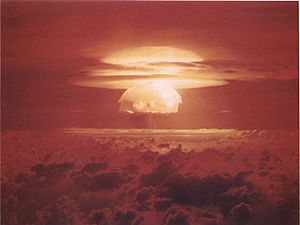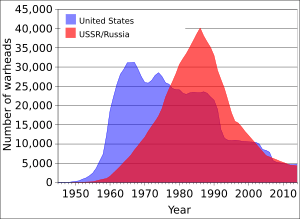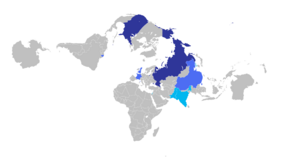Nuclear holocaust facts for kids

A nuclear holocaust is a scary idea where many nuclear weapons explode all over the world. This would cause huge destruction and spread dangerous radioactive dust. In this idea, large parts of Earth would become unsafe to live in. This could lead to the breakdown of civilization, the end of humanity, or even the end of most biological life on Earth.
Besides cities being destroyed by nuclear blasts, a nuclear war could cause massive firestorms, a "nuclear winter" (where the Earth gets very cold), and widespread radiation sickness from radioactive fallout. It could also temporarily or permanently disable most modern technology because of electromagnetic pulses (EMP). Some scientists believe a full nuclear war could end modern civilization. For example, Earth's average temperature could drop by 7–8 °C (13–15 degrees Fahrenheit) for several years.
Early studies during the Cold War thought billions of people would survive the immediate effects. However, groups like the International Physicians for the Prevention of Nuclear War believe nuclear war could indirectly lead to human extinction through environmental damage, society breaking down, and economic problems.
The idea of a nuclear holocaust is very important to the anti-nuclear movement, which works to prevent nuclear war. It's also part of the idea called Mutual assured destruction (MAD), which means if one country attacks with nuclear weapons, the other will too, leading to both being destroyed. This scenario is also common in books and movies, especially in science fiction and post-apocalyptic stories.
Contents
What is a Nuclear Holocaust?
The word "holocaust" comes from a Greek word meaning "completely burnt." It refers to a huge amount of destruction and loss of life, especially by fire.
How Likely is a Nuclear War?
As of 2021, humanity has about 13,410 nuclear weapons. Thousands of these are ready to be launched very quickly. Even though the number of weapons has gone down since the Cold War ended, every country with nuclear weapons is making their weapons more modern.
The Bulletin of the Atomic Scientists uses a symbolic Doomsday Clock to show how close humanity is to global disaster. In January 2020, they moved the clock to 100 seconds before midnight. In 2023, it moved even closer, to 90 seconds before midnight. This shows how serious the threat is.
During the Cuban Missile Crisis, John F. Kennedy thought there was a 33% to 50% chance it could turn into a nuclear conflict.
Scientists say that even a small nuclear war between two countries, like India and Pakistan, could have terrible effects worldwide. These smaller conflicts are actually more likely than a full-scale global nuclear war.
Could Humans Become Extinct?

Many experts have thought that a global nuclear war, especially with the huge stockpiles from the Cold War, could lead to humans becoming extinct. This idea became stronger when the concept of "nuclear winter" was first studied in 1983.
However, more recent studies suggest that total extinction is very unlikely. They believe some parts of the world would still be livable. But the risk is not zero, because the climate effects of nuclear war are still uncertain. There could also be indirect risks, like society completely breaking down after a war, which would make humanity much more vulnerable to other dangers.
Some scientists in the 1950s, like Leo Szilard, warned about a "doomsday device." This would be a powerful hydrogen bomb surrounded by a large amount of cobalt. Cobalt has a half-life of five years. Some physicists thought its global fallout could kill all human life through deadly radiation.
Effects of a Nuclear War
It's hard to know exactly how many people would die in a global nuclear war. Scientists are always learning new things about nuclear weapons and updating their models.
An early report in 1979 looked at direct deaths from blasts and radiation. It also considered indirect effects like economic and social problems. This report was made when there were many more nuclear weapons than today. It also didn't consider "nuclear winter" or electromagnetic pulses (EMP).
Nuclear Winter
In the early 1980s, scientists started thinking about the smoke and soot from burning cities after nuclear explosions. They thought the intense heat would send these tiny particles very high into the atmosphere. There, they could float for weeks, blocking out most of the sun's light.
A famous study in 1983 by the "TTAPS team" (Richard P. Turco, Owen Toon, Thomas P. Ackerman, James B. Pollack and Carl Sagan) was the first to model these effects. They called it "nuclear winter."
More recent studies use powerful computers and better models. A 2007 study looked at a global nuclear war using a large part of today's weapons. It found that temperatures could drop by about 12–20 °C (22–36 degrees Fahrenheit) in major farming areas like the US, Europe, Russia, and China. Some parts of Russia could get as cold as 35 °C (63 degrees Fahrenheit) colder for the first two summer growing seasons.
These changes would last much longer than first thought, possibly 10 years. Also, global cooling would reduce rainfall by about 45% worldwide. This would make it very hard to grow food.
Scientists believe that even small, regional nuclear conflicts could affect the global climate for a decade or more. For example, if two countries in warm areas each used 50 Hiroshima-sized nuclear weapons on cities, it could release five million tons of soot. This would cause temperatures to drop by several degrees in large parts of North America and Eurasia, including most grain-growing regions. This cooling would last for years and could be "catastrophic." Rainfall would also drop by 10% globally.
A regional nuclear war could also seriously damage the ozone layer. A 2008 study found it could create a near-global "ozone hole." This would cause human health problems and hurt agriculture for at least a decade.
Nuclear Famine
It's hard to guess how many people would die from nuclear winter. But the main effect would likely be a worldwide famine, meaning mass starvation. This would happen because farming and food distribution would be ruined.
Reports in 2013 and 2022 from the International Physicians for the Prevention of Nuclear War (IPPNW) warned that over two billion people, about a third of the world's population, would be at risk of starvation. This could happen even from a regional nuclear exchange between India and Pakistan, or if only a small part of the nuclear weapons held by America and Russia were used.
Several studies agree that farming would be greatly reduced for years due to climate changes from nuclear wars. Less food would also cause food prices to rise, affecting hundreds of millions of vulnerable people, especially in the world's poorest countries.
A study in August 2022 suggested that a full-scale nuclear war between the U.S. and Russia could directly kill 360 million people. More than 5 billion people might die from starvation due to soot from firestorms after nuclear bombing. A smaller war between India and Pakistan could cause over 2 billion deaths.
Electromagnetic Pulse (EMP)
An electromagnetic pulse (EMP) is a sudden burst of electromagnetic radiation. Nuclear explosions create a special kind of EMP called a nuclear EMP or NEMP. This EMP can damage or disrupt electronic equipment.
By disabling electronics, an EMP could shut down hospitals, water treatment plants, food storage facilities, and all electronic communication. This would threaten key parts of modern life. Some EMP attacks could cause a huge loss of power for months or even years. Today, if the power grid fails, we get help from other areas. But after an EMP attack, that help wouldn't exist, and all damaged electronics would need to be completely replaced.
In 2013, the US House of Representatives looked at a law to protect large power transformers. The problem of protecting civilian infrastructure from EMP has also been studied in Europe, especially in the United Kingdom. While some precautions have been taken, some experts believe an EMP is a very significant threat.
However, some scientists argue that the risk of EMP from rogue states is often exaggerated by the news. They say that such weapons are too small and uncoordinated to cause a massive EMP. Also, underground infrastructure is usually protected, and we would get enough warning from solar observatories like SOHO to protect surface transformers if a dangerous solar storm was detected.
Nuclear Fallout
One part of a nuclear holocaust is worldwide fallout. This global fallout has happened before from thousands of past nuclear weapons tests, many of which were in the atmosphere. A quick rise in global background radiation, which peaked in 1963, led to countries signing bans on nuclear weapons testing.
Global fallout has caused deaths, for example, through higher cancer rates. Estimates from 2020 suggest about 2.4 million people worldwide have died from it.
Nuclear fallout is the radioactive dust and ash that goes into the upper atmosphere after a nuclear explosion. This dust is very dangerous. Most of the particles decay quickly, but some radioactive particles can last for seconds to a few months. Some, like strontium-90 and caesium-137, last a very long time and can create radioactive "hot spots" for up to 5 years.
Fallout and "black rain" (rain darkened by soot) can contaminate water, farms, and soil. Contact with radioactive materials can lead to radiation poisoning. High doses of radiation over a short time can cause severe illness and death. Over longer periods, cancer becomes the main health risk. Long-term radiation exposure can also affect human development before birth and cause genetic damage that can be passed down.
See also
- Second Cold War
- Environmental impact of war
- Global catastrophic risk
- Human extinction
- List of nuclear holocaust fiction
- Nuclear anxiety
- Nuclear terrorism
- Silurian hypothesis
- World War III


